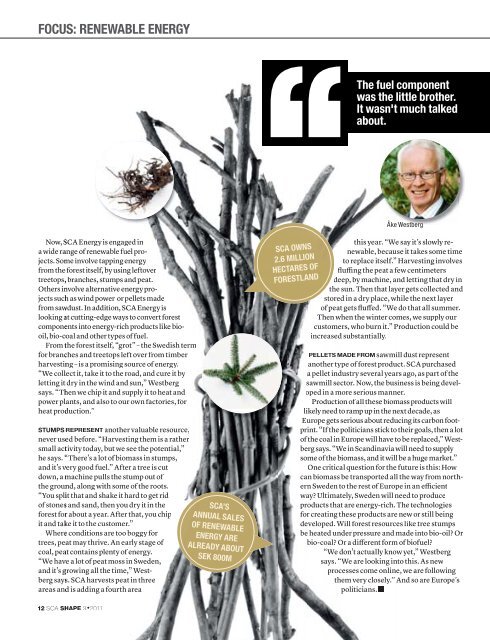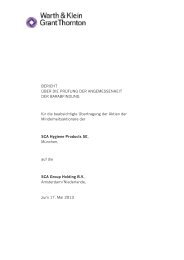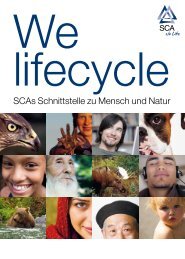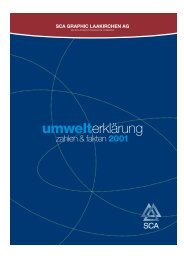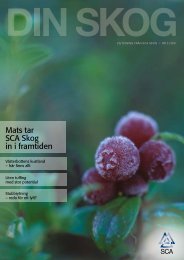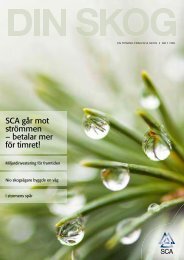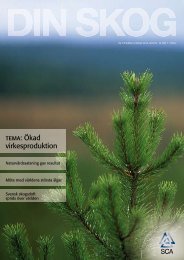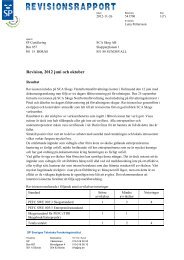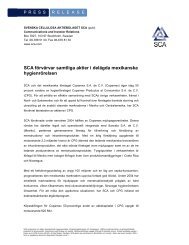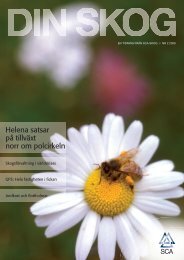You also want an ePaper? Increase the reach of your titles
YUMPU automatically turns print PDFs into web optimized ePapers that Google loves.
FOCUS: RENEWABLE ENERGY<br />
Now, <strong>SCA</strong> Energy is engaged in<br />
a wide range of renewable fuel projects.<br />
Some involve tapping energy<br />
from the forest itself, by using leftover<br />
treetops, branches, stumps and peat.<br />
Others involve alternative energy projects<br />
such as wind power or pellets made<br />
from sawdust. In addition, <strong>SCA</strong> Energy is<br />
looking at cutting-edge ways to convert forest<br />
components into energy-rich products like biooil,<br />
bio-coal and other types of fuel.<br />
From the forest itself, “grot” – the Swedish term<br />
for branches and treetops left over from timber<br />
harvesting – is a promising source of energy.<br />
“We collect it, take it to the road, and cure it by<br />
letting it dry in the wind and sun,” Westberg<br />
says. “Then we chip it and supply it to heat and<br />
power plants, and also to our own factories, for<br />
heat production.”<br />
STUMPS REPRESENT another valuable resource,<br />
never used before. “Harvesting them is a rather<br />
small activity today, but we see the potential,”<br />
he says. “There’s a lot of biomass in stumps,<br />
and it’s very good fuel.” After a tree is cut<br />
down, a machine pulls the stump out of<br />
the ground, along with some of the roots.<br />
“You split that and shake it hard to get rid<br />
of stones and sand, then you dry it in the<br />
forest for about a year. After that, you chip<br />
it and take it to the customer.”<br />
Where conditions are too boggy for<br />
trees, peat may thrive. An early stage of<br />
coal, peat contains plenty of energy.<br />
“We have a lot of peat moss in Sweden,<br />
and it’s growing all the time,” Westberg<br />
says. <strong>SCA</strong> harvests peat in three<br />
areas and is adding a fourth area<br />
12 <strong>SCA</strong> SHAPE 3<strong>2011</strong><br />
<strong>SCA</strong>’S<br />
ANNUAL SALES<br />
OF RENEWABLE<br />
ENERGY ARE<br />
ALREADY ABOUT<br />
SEK 800M<br />
<strong>SCA</strong> OWNS<br />
2.6 MILLION<br />
HECTARES OF<br />
FORESTLAND<br />
The fuel component<br />
was the little brother.<br />
It wasn't much talked<br />
about.<br />
Åke Westberg<br />
this year. “We say it’s slowly renewable,<br />
because it takes some time<br />
to replace itself.” Harvesting involves<br />
fl uffi ng the peat a few centimeters<br />
deep, by machine, and letting that dry in<br />
the sun. Then that layer gets collected and<br />
stored in a dry place, while the next layer<br />
of peat gets fl uff ed. “We do that all summer.<br />
Then when the winter comes, we supply our<br />
customers, who burn it.” Production could be<br />
increased substantially.<br />
PELLETS MADE FROM sawmill dust represent<br />
another type of forest product. <strong>SCA</strong> purchased<br />
a pellet industry several years ago, as part of the<br />
sawmill sector. Now, the business is being developed<br />
in a more serious manner.<br />
Production of all these biomass products will<br />
likely need to ramp up in the next decade, as<br />
Europe gets serious about reducing its carbon footprint.<br />
“If the politicians stick to their goals, then a lot<br />
of the coal in Europe will have to be replaced,” Westberg<br />
says. “We in Scandinavia will need to supply<br />
some of the biomass, and it will be a huge market.”<br />
One critical question for the future is this: How<br />
can biomass be transported all the way from northern<br />
Sweden to the rest of Europe in an effi cient<br />
way? Ultimately, Sweden will need to produce<br />
products that are energy-rich. The technologies<br />
for creating these products are new or still being<br />
developed. Will forest resources like tree stumps<br />
be heated under pressure and made into bio-oil? Or<br />
bio-coal? Or a diff erent form of biofuel?<br />
“We don’t actually know yet,” Westberg<br />
says. “We are looking into this. As new<br />
processes come online, we are following<br />
them very closely.” And so are Europe’s<br />
politicians.


